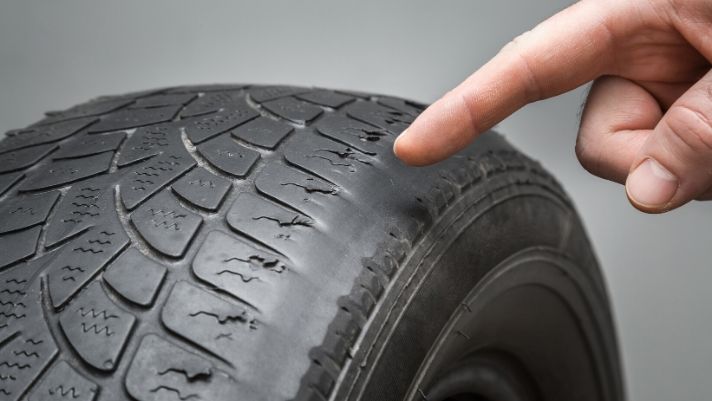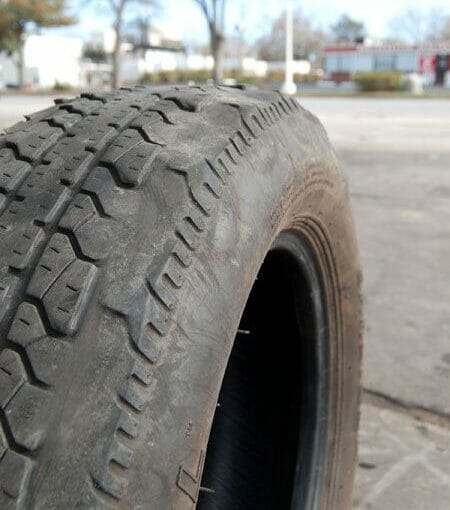Scalloped Tire Wear Patterns
When you take a close look at your car’s tires, you may notice a wear pattern that looks like waves or scallops. This type of tire wear is known as scalloping and can be caused by several different factors. Scalloped tire wear can make your tires less effective at gripping the road, which can lead to decreased performance and fuel economy.
In extreme cases, it can even cause your tires to fail.
If you notice your tires are wearing down in a scalloped pattern, it’s time for a tire rotation! This type of wear is caused by improper alignment and can lead to uneven tread wear. Over time, this can cause your tires to become bald in spots and could eventually lead to a blowout.
A tire rotation is a simple fix that involves switching the position of your tires. This helps distribute the wear evenly and can extend the life of your tires. If you’re not sure how to rotate your tires, consult your owner’s manual or ask a professional at your local auto shop.
What Causes Tire Cupping
One of the most common causes of tire cupping is improper alignment. When your tires are properly aligned, they rotate evenly as you drive down the road. But when they’re out of alignment, they can start to wobble and vibrate.
This can cause the tread to wear down unevenly, eventually leading to cupping.Other causes of tire cupping include:• Worn suspension components: If your shocks or struts are worn out, they can’t do their job of absorbing bumps in the road.
That means your tires will take the brunt of the impact, which can lead to cupping.• Bald spots: If there’s already a bald spot on your tire, it’s more likely to cup because there’s less tread to support the weight of your car.• Loose wheel bearings: If your wheel bearings are loose, it can cause your tires to wobble as you drive.
This can lead to uneven tread wear and eventuallycupping.
What Causes Cupping on Front Tires
Cupping is a condition that affects the tread of your tires, and it is caused by uneven wear. The tread is designed to flex as the tire rolls over the ground, but if there is too much flexing, it can cause the tread to separate from the tire’s body. This separation causes cupping, which looks like small dips or divots in the tire’s surface.
There are several things that can cause cupping:1. Poorly aligned wheels: If your wheels are not properly aligned, they will cause your tires to scrub against the road surface as you drive. This scrubbing action wears down the tread unevenly, and can eventually lead to cupping.
2. Worn suspension components: Your vehicle’s suspension system helps to keep the tires in contact with the road surface. If any of the components are worn out or damaged, it can affect tire wear and may lead to cupping.3. Hard braking: Repeated hard braking can also cause cupping because it puts additional stress on the tires’ treads.
Try to avoid hard braking whenever possible, and have your brakes checked regularly to ensure they are in good condition.
How to Fix Choppy Tires
If your car has choppy tires, it’s likely that the problem is with the alignment. To fix this, you’ll need to take your car to a mechanic or tire shop and have them adjust the alignment. This should solve the problem and allow your car to drive smoothly again.
Tire Cupping Symptoms
If you notice your vehicle handling differently or if your ride is becoming rougher, it may be due to tire cupping. This condition occurs when parts of the tire’s tread wear down unevenly, causing a “cup” shape to form. Keep an eye out for the following symptoms:
Uneven tread wear: If you see that your tires are wearing down in a pattern that looks like cups, then this is likely the issue.Vibrations: As cupping worsens, you may start to feel vibrations coming from the affected tire. This is caused by the flat spot on the tire making contact with the ground as you drive.
Decreased fuel efficiency: Because tire cupping can cause your vehicle to handle differently, you may find yourself using more fuel than usual as you try to maintain control.Tire cupping is most often caused by improper alignment or suspension issues. If not addressed, it can lead to premature tire wear and even blowouts.
Be sure to have your vehicle checked out by a professional if you suspect that this may be an issue.
Mud Tire Cupping
Mud tire cupping is a common problem for off-roaders and can be caused by a number of factors. The most common cause is simply driving on uneven or rough terrain which causes the tread to wear down unevenly. This can also be caused by underinflated tires, overloading the vehicle, or even just normal wear and tear.
If you suspect that your tires are beginning to cup, it’s important to have them inspected by a professional as soon as possible. Cupped tires will continue to deteriorate and will eventually need to be replaced. In the meantime, you may experience reduced traction and handling as well as increased noise levels from your tires.
If you frequently drive off-road, it’s a good idea to inspect your tires regularly for any signs of cupping. By catching the problem early, you can avoid expensive repairs or replacements down the road.

Credit: rnrtires.com
What Causes a Scalloped Wear Pattern on the Tires?
A scalloped wear pattern on the tires is most likely caused by an alignment issue. When the toe or camber settings are not within factory specifications, it can cause the tire to scrub against the pavement as it rolls forward. This can result in a characteristic “feathering” pattern of wear on the tread surface.
If you suspect your vehicle may be out of alignment, have it checked by a qualified technician as soon as possible.
What is Scalloped Tire Wear?
When your tires start to show wear in a pattern that looks like scallops or crescent moons, it’s called scalloped tire wear. Once you start to see this pattern of wear, it’s an indication that your tires need to be replaced.There are a few different reasons why scalloped tire wear can occur.
One is simply because of the way your car is driven. If you tend to take corners at high speeds or make sudden stops often, this type of tire wear can occur. Another reason for scalloped tire wear is incorrect wheel alignment.
When your wheels are not aligned properly, it puts extra stress on your tires and can cause this type of premature wearing.If you notice scalloped tire wear, it’s important to get new tires as soon as possible. Once this type of wear starts, it will only get worse and can lead to a blowout or other serious safety issue while driving.
How Can You Tell If Your Tires are Scalloped?
If your vehicle is showing signs of decreased performance, it may be due to scalloped tires. Here are four ways to tell if your tires are scalloped:1. Uneven tread wear.
If you notice that the tread on your tires is wearing down unevenly, this could be a sign that they’re scalloped. The uneven wear pattern will typically appear as dips or “valleys” in the tread.2. Vibrations while driving.
Another common symptom of scalloped tires is vibrations coming from the vehicle while driving. This can be caused by the tire’s tread being out of balance due to the uneven wear pattern.3. Decreased fuel economy.
Scalloped tires can also lead to decreased fuel economy as they create more resistance when rolling down the road. This resistance causes the engine to work harder, which uses up more fuel.4 .
Increased tire noise . Finally, one way to tell if your tires are scalloped is by increased tire noise when driving . This is caused by the irregularity in the tire’s tread pattern , which creates a humming sound as it comes into contact with the road surface .
How Do You Fix a Scalloped Tire?
If you have a scalloped tire, it’s important to get it fixed as soon as possible. While it may not seem like a big deal, a scalloped tire can actually be quite dangerous. Here’s how to fix a scalloped tire:
1. First, you’ll need to identify the cause of the problem. If you hit a pothole or something else that caused the tires to lose air pressure, then you’ll need to repair or replace the tire. However, if the problem is simply wear and tear, then you can patch up the tire yourself.
2. Once you know what caused the problem, it’s time to start fixing it. If you need to replace the tire, take it to your nearest auto shop or dealership. They will be able to help you find the right replacement tire for your car.
3. If you’re going to patch up the tire yourself, there are a few things you’ll need: A rubber patch kit, vulcanizing cement, and an air compressor. Start by cleaning off the area around the hole in the tire with alcohol wipes. Then use a knife or scissors to cut out any jagged edges around the hole.
4. Next, apply vulcanizing cement around the hole and place your rubber patch over top of it. Make sure that there are no bubbles in between the cement andpatch – this will weaken the bond between them. Use something heavy (like a book)to press down on top ofthe patch while it dries/cures – this usually takes about 24 hours.
.5 After 24 hours have passed, checkto make surethatthe patch is fully cured/dry before proceeding..6 Now it’s time touseyourair compressor totopupthepressureinyourtiretothecorrectlevel..7 Onceyou’vedone that,,youshouldbegoodtogo!
Justmake suretocheckyourtirepressureregularlyfromnowonand keepaneyeoutforanyfurthersigns oftrouble.
Tire Wear Patterns And What They Mean?
Conclusion
If you’re a driver, you know that different types of tire wear can be caused by different factors. For example, if your tires are wearing unevenly, it could be due to something as simple as overinflation or underinflation. But what about those scalloped wear patterns that sometimes show up on tires?
What causes them?Generally speaking, scalloped tire wear is caused by driving habits. If you tend to drive aggressively, making a lot of quick starts and stops, or if you frequently take sharp turns, you’re more likely to see this type of wear pattern on your tires.
The good news is that it’s usually not serious and can be easily remedied by changing your driving habits.So, if you start to notice scalloped wear patterns on your tires, try backing off the gas a bit and giving yourself more time to make turns. With a little bit of care, you should be able to avoid this issue altogether.


